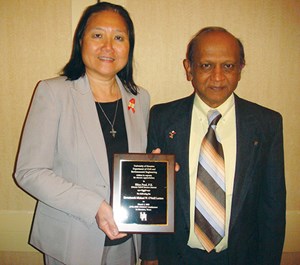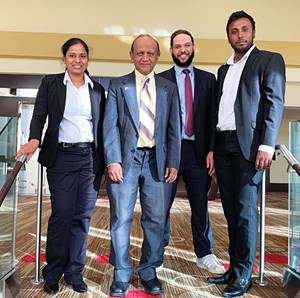May 2023 Vol. 78 No. 5
Features
CIGMAT 2023: Infrastructure, energy, geotechnical, flooding, sustainability issues
(UI) — The 28th “Infrastructure, Energy, Geotechnical, Flooding and Sustainable Issues Related to Houston and Other Major Cities,” organized by the Center for Innovative Grouting Materials and Technology (CIGMAT) and the Department of Civil and Environmental Engineering, University of Houston on was held on March 3, at the University of Houston Hilton.
More than 300 people and 14 invited speakers attended the one-day conference and exhibition, with attendees representing owners, consulting engineers, material supplies, contractors and academia.
General Session
Welcome remarks by Professor C. Vipulanandan, director of CIGMAT and Texas Hurricane Center for Innovative Technology (THC-IT), highlighted the need for such a conference in highlighting the experiences in major cities with the rapid growth in the population, new technologies and economic activities with changing conditions and regulations.
While Houston is the energy capital of the United States with the largest medical center in the world, there is ever increasing need for expanding the infrastructures, meeting the energy demand and integrating the advances in technologies to meet the population growth and industrial expansion with the impact of natural disasters like hurricanes, tornadoes, winter-storms and flooding.
The General Session focused on expanding the highway transportation infrastructures, innovative solutions for public works and the energy needs around the world for the next few decades.
Varuna Singh, deputy district engineer Houston District – Texas Department of Transportation discussed some of the major projects that will be completed this year, and several projects – valued at over several billion dollars in the greater Houston area – that will start in the next few years. He also addressed plans for resolving the safety issues associated with Houston’s ranking very high nationally in traffic congestion problems.
Other topics were related to environmental issues, maintenance and funding for the Department of Transportation. Michael Ereti, director of Capital Projects at the city of Houston Public Works, discussed recent updates on construction management programs, debris management and challenges after flooding, and new plans for continuing various operations with the growing population.
Sid Mebarkia, senior principal engineer for Chevron-Subsea Pipelines, covered the subsea pipeline infrastructures for the transport of oil, gas and other products across vast distances beneath the ocean floor. These pipelines are critical components of the global energy supply chain, enabling the safe and efficient movement of resources from offshore production facilities to onshore processing facilities or distribution points.
However, like all infrastructures, subsea pipelines are subject to a range of issues and challenges that can affect their operation and integrity. Such challenges include corrosion, fatigue and natural disasters. Smart monitoring systems and smart networks implemented in digital twins will help provide real-time data to not only safeguard the pipeline infrastructures but to also optimize its operation. New and smart materials will further be leveraged to increase the robustness of the pipeline infrastructure.
Four technical sessions were then held on various topics to highlight the growth, challenges and changes happening in and around major cities.

Flooding, Treatment Plant Construction, Subsidence
The first panel discussion, moderated by Rafael Ortega from Aurora Technical Services, was titled “Flooding, Water Treatment Plant Construction and Subsidence Issues.”
Atul Hannan, director of planning at Harris County Flood Control, discussed how Harris County Flood Control District and the Federal Emergency Management Agency (FEMA) are working together to deliver the Modeling, Assessment and Awareness Project (MAAPnext).
This flood hazard assessment project uses the latest available technology and data to produce the most comprehensive set of flood hazard maps and information to-date for all watersheds within Harris County. The updated information from MAAPnext will impact how future projects, new development and associated flood mitigation strategies are planned and implemented.
Now that MAAPnext data has been compiled by the Flood Control District and submitted to FEMA, the goal is to build community awareness prior to FEMA’s release of preliminary Flood Insurance Rate Maps (FIRMs), anticipated to occur in 2023.
Eric Garza, assistant director from the city of Houston Water, discussed the Northeast Water Purification Plant (NEWPP) Facilities and On-going Expansion Work, initiated in response to subsidence regulations in the region, which required the conversion of ground water to surface water supplies.
By 2025, Houston and its four Authority partners (North Harris County Regional Water Authority, West Harris County Regional Water Authority, North Fort Bend Water Authority and Central Harris County Regional Water Authority) will be responsible for supplying 60 percent of their annual water distribution from surface sources.
NEWPP Expansion is one of the largest water treatment projects under construction in North America. When completed, it will deliver 320 million gallons of drinking water per day to over 2 million citizens through Harris and Fort Bend Counties. The project is nearing the 80-percent completion mark and will begin producing the first installment of drinking water sometime in 2023.
Michael J. Turco, general manager at the Harris/Galveston Subsidence District (HGSD), reviewed and updated the district’s programs and issues in working with various cities and counties to comply with the new rules and regulations.
Transportation, helical piles
The second session, “Transportation Projects and Helical Piles,” was moderated by Daniel Wong, from Tolunay-Wong Engineers, Houston.
Brian P. Alcott, assistant director at Harris County Toll Road Authority (HCTRA), covered ongoing projects and plans to continue evolving the mobility system to meet the diverse connectivity needs of all of Harris County residents.
Established in 1988, the current tollway system is about 130 centerline miles and current system improvements account for approximately $3.8 billion.
Shri Reddy, executive vice president at METRO-Planning Engineering and Construction, talked about the Houston region’s steady growth post-COVID-19 pandemic. Freeway traffic is nearing pre-pandemic levels and transit ridership is rising steadily each month. Travel patterns are changing with work-from-home being an option, but traffic fatalities are still on the rise. The challenge is what actions the region should take to address transportation alternatives and safety, which are critical to the quality of life.
Moncef Souissi, senior geotechnical engineer from Cantsink, in Liburn, Ga., talked about helical piles design theory and applications.
Used in construction applications for over a century, helical piles have gained popularity in the last 30 to 40 years to the extent they are more frequently recommended by design professional engineers, compared to many other deep foundation types. In 2009, the International Building Code (IBC) revision added helical piles: the main components of a helical pile, pile installation process, various applications, mechanical and soil pile capacities, and the methods used to determine them.
The presentation also included the design of helical piles using theoretical methods that are based on traditional soil mechanics and the well-known capacity-torque correlation, which is probably the most significant attribute of helical piles.
Water, wastewater issues
The third session, on “Water and Wastewater Issues,” was moderated by Mackrena Ramos from Lockwood, Andrews and Newnam, Houston, Texas.
Jeff Haby, vice president of production and treatment at San Antonio Water System (SAWS), talked about the steps SAWS has taken toward water resiliency, especially recycling, aquifer storage and recovery, and brackish desalination. Prompted by Winter Storm Uri, in 2021, another approach is providing backup power generation at critical water pump stations to ensure service in case of a loss of power.
James A. Golab, manager of the Innovative Water Technologies (IWT) Department) of the Texas Water Development Board (TWDB), discussed the mission of TWDB as leading the state’s efforts to ensure a secure water future for its citizens. To accomplish this goal, TWDB provides water planning, data collection, financial assistance and technical assistance services across the state.
Created in 2002, IWT is focused on alternative water supplies including aquifer storage and recovery, aquifer recharge, desalination and water reuse. Its primary goals are to participate in research and demonstration projects, develop publications and other educational material, and disseminate information to the public through various outreach activities. IWT publishes a biennial report on desalination in Texas for the state legislature and the ninth report in this series was released in 2022.
Jan B. Conant, coatings specialist at Warren Environmental, addressed high-build epoxy coatings for protecting and rehabilitating critical infrastructure assets. This included details about their attributes and physical properties, uses, compatible substrates, application methods and available application network. Also, several case studies related to pipelines, manholes and wastewater treatment facilities were discussed.
Formulated to provide structural renewal for deteriorated structures, the product exhibits tremendous adhesion to various substrates, such as concrete, brick and steel. Additional features include structural enhancement, proven resistance to H2S corrosion found in aggressive sewer environments and treatment chemicals like chlorine and ozone, and zero volatile organic compounds (VOCs).
Smart foam cement
The last technical presentation, by C. Vipulanandan, was entitled “Smart Foam Cement Quality Control and Behavior Characterized Using Artificial Neural Network (ANN) and Vipulanandan Models.”
There is increasing interest in using light-weight cement slurries with foam additions in multiple applications including onshore and offshore deep wells installed in varying and challenging geological formations with low strength rocks.
Recently highly sensing smart foam cement has been developed to real-time monitor the changes in the material. Also, foam cement has reduced thermal conductivity making it a better insulator. It is also important to model the behavior of the smart foam cement for real-time monitoring with the Artificial Neural Network (ANN) model for adaptation in machine learning for various applications.
The investigation was on the performance of highly sensing foam added smart cement and verified with various behavior models. Highly sensing smart oil well cement with water-to-cement (w/c) ratio of 0.38 was modified by adding 5 percent and 20 percent foam by weight. This was first characterized using the impedance–frequency response to identify the critical electrical property for monitoring. Based on the Vipulanandan Impedance Model, electrical resistivity was the monitoring property.
For quality control of the mixing in the field, the electrical resistivity can be used and with 5 percent and 20 percent foam addition, electrical resistivity increased by 14 percent and 94 percent and Vipulanandan correlation model was used to relate the density to the resistivity.
In addition, rheological properties and piezoresistivity (slurry) were investigated. With the addition of 20 percent foam, the smart foam cement density reduced by 45 percent and thermal conductivity reduced by 65 percent. Also, initial resistivity increased by 94 percent, indicating a potential quality control parameter for monitoring in the field. The thermal conductivity and the initial resistivity were related to the density using the Vipulanandan Correlation Model.
The slurries investigated were piezoresistive; when pressure was applied, the electrical resistivity changed. The rheological behavior of the smart foam cement slurries has been quantified using the new Vipulanandan rheological model and compared with Artificial Neural Network (ANN) Model. The slurry piezoresistivity model was used to predict the piezoresistive behavior and compared it to the ANN model. Accuracies of all the model predictions were compared using the statistical parameters, such as the root mean square error (RMSE) and the coefficient of determination.
Wrap-up
A reception followed the technical sessions during which posters on research activities at CIGMAT and in the Department of Civil and Environmental Engineering were displayed. A number of grouting, pipe manufacturers, material suppliers, pipe condition monitoring, geotechnical engineering and waste water rehabilitation companies participated in the exhibition.
A CIGMAT 2023 Conference Proceedings was published and is posted on the CIGMAT web site (http://cigmat.cive.uh.edu).
The next CIGMAT conference (CIGMAT-2024) will be held on March 1, 2024, at the University Hilton, University of Houston.





Comments